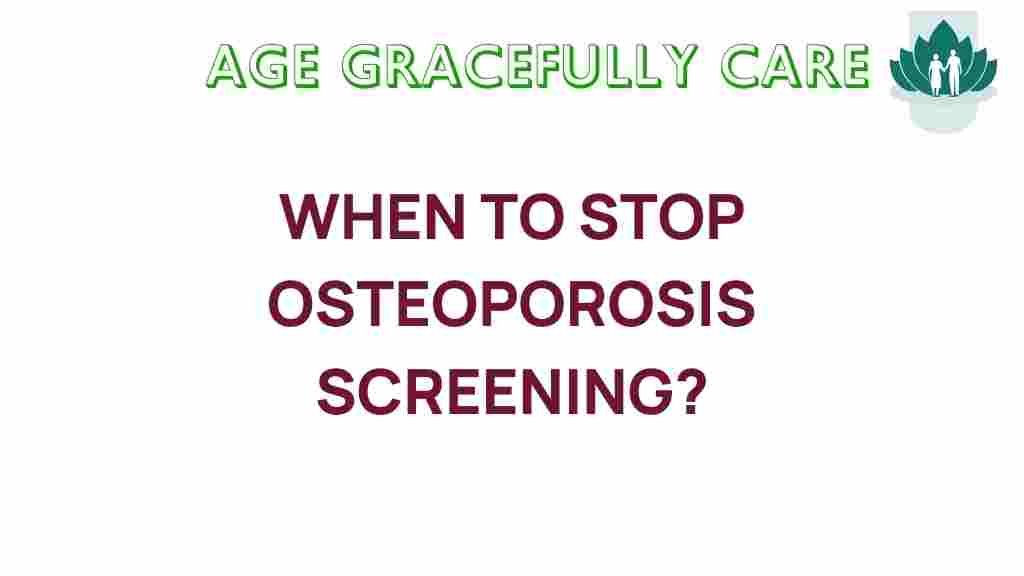The Critical Question: When Should You Stop Osteoporosis Screening?
Osteoporosis is a significant health concern, especially as individuals age. With its potential to lead to fractures and debilitating health conditions, understanding when to stop osteoporosis screening is crucial for maintaining bone health and overall wellness. This article explores essential factors surrounding osteoporosis, including screening guidelines, age considerations, risk factors, and the importance of prevention, particularly in women’s health.
Understanding Osteoporosis and Its Impact
Osteoporosis is a condition characterized by weakened bones, increasing the risk of fractures. It’s often referred to as a “silent disease” because bone loss occurs without symptoms. According to the National Osteoporosis Foundation, approximately 10 million Americans have osteoporosis, and another 44 million have low bone density, placing them at risk for this debilitating condition.
Why Screening for Osteoporosis Matters
Screening is critical for early detection of osteoporosis, which can lead to better management and prevention strategies. The primary method for screening is through a bone density test (DEXA scan), which measures the density of bones and helps identify individuals at risk of fractures.
Current Guidelines for Osteoporosis Screening
Guidelines for osteoporosis screening have been established by various health organizations to help clinicians make informed decisions. Here are the current recommendations:
- **Women aged 65 and older** should be screened for osteoporosis.
- **Younger women** with risk factors such as family history, body weight below 127 pounds, and prior fractures should also be screened.
- **Men aged 70 and older** or younger men with risk factors should be screened, although guidelines are less clear than for women.
- **Postmenopausal women** under age 65 with risk factors should undergo screening.
These guidelines emphasize the importance of assessing individual risk factors, as they play a crucial role in determining the need for screening.
Key Risk Factors for Osteoporosis
Several risk factors contribute to the likelihood of developing osteoporosis, including:
- **Age**: Risk increases with age, particularly after menopause for women.
- **Gender**: Women are at a higher risk than men due to lower peak bone mass and hormonal changes.
- **Family History**: A family history of osteoporosis or fractures can indicate higher risk.
- **Body Weight**: Low body weight increases the risk of bone density loss.
- **Lifestyle Factors**: Smoking, excessive alcohol consumption, and lack of physical activity significantly contribute to bone health.
- **Medical Conditions**: Certain diseases such as rheumatoid arthritis, hyperthyroidism, and gastrointestinal issues can affect bone density.
- **Medications**: Long-term use of steroids and some other medications can lead to bone loss.
When to Consider Stopping Osteoporosis Screening
As individuals age, the question arises: when should you stop osteoporosis screening? This decision can be complex and depends on several factors:
- **Age**: Many guidelines suggest that screening may be less beneficial for individuals over 85, particularly if they have already been diagnosed with osteoporosis.
- **Health Status**: If an individual has a limited life expectancy due to chronic illness or other health issues, the benefits of ongoing screening may be outweighed by the risks.
- **Previous Results**: If previous screenings have shown normal bone density or minimal risk, continuing to screen may not be necessary.
- **Quality of Life**: Consideration of the individual’s overall health, mobility, and quality of life is essential in making this decision.
A Step-by-Step Process for Decision Making
When considering whether to continue or stop osteoporosis screening, follow this process:
- **Assess Age and Gender**: Identify if you fall into the recommended screening categories based on age and gender.
- **Evaluate Risk Factors**: Review personal and family medical history to determine risk factors.
- **Consult Healthcare Providers**: Discuss with your doctor about your health status, previous screening results, and any changes in your health.
- **Consider Quality of Life**: Reflect on how osteoporosis and screening impact your daily life and well-being.
- **Make an Informed Decision**: Together with your healthcare provider, decide the best course of action regarding screening.
Preventing Osteoporosis: Beyond Screening
While screening is vital, prevention plays an equally critical role in managing osteoporosis. Here are some effective prevention strategies:
- **Nutrition**: Ensure adequate intake of calcium and vitamin D through diet or supplements.
- **Exercise**: Engage in weight-bearing and muscle-strengthening exercises to improve bone density.
- **Healthy Lifestyle Choices**: Avoid smoking and limit alcohol consumption.
- **Regular Check-Ups**: Maintain regular visits with your healthcare provider to monitor bone health.
For more information on prevention strategies, visit the National Osteoporosis Foundation.
Troubleshooting Common Concerns
Many individuals have concerns about osteoporosis screening and management. Here are some common questions and answers:
- What if my screening results are abnormal?
Follow-up with your healthcare provider to discuss treatment options, including medications or lifestyle changes. - How often should I be screened?
Typically, screening is recommended every 2 years, but this may vary based on individual risk factors. - Are there any risks associated with screening?
Bone density tests are non-invasive and carry minimal risk; however, it’s essential to discuss any concerns with your provider.
Conclusion: Making Informed Decisions About Osteoporosis Screening
Determining when to stop osteoporosis screening is a critical decision that hinges on multiple factors, including age, health status, and individual risk factors. By understanding the guidelines, assessing personal health, and consulting with healthcare providers, individuals can make informed choices about their screening needs.
As we navigate the complexities of osteoporosis, remember that prevention is key. Engage in healthy lifestyle choices, regular check-ups, and open discussions with your healthcare team to maintain optimal bone health. For further reading on women’s health and osteoporosis, check out this comprehensive guide.
This article is in the category Health and created by AgeGracefullyCare Team
